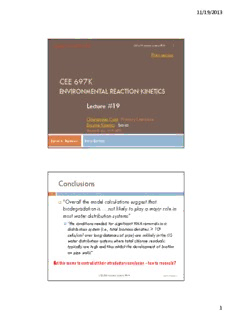
CEE 697K - University of Massachusetts Amherst PDF
Preview CEE 697K - University of Massachusetts Amherst
11/19/2013 Updated: 19 November 2013 CEE 679 Kinetics Lecture #19 1 Print version CEE 697K ENVIRONMENTAL REACTION KINETICS Lecture #19 Chloramines Cont: Primary Literature Enzyme Kinetics: basics Brezonik, pp. 419-450 David A. Reckhow Introduction Conclusions 2 “Overall the model calculations suggest that biodegradation is…..not likely to play a major role in most water distribution systems” “the conditions needed for significant HAA removals in a distribution system (i.e., total biomass densities > 105 cells/cm2 over long distances of pipe) are unlikely in the US water distribution systems where total chlorine residuals typically are high and thus inhibit the development of biofilm on pipe walls” But this seems to contradict their introductory conclusion –how to reconcile? CEE 679 Kinetics Lecture #19 David A. Reckhow 1 11/19/2013 What could they have concluded? 3 Variability vs diurnal demand 30 25 20 Q/Qavg 15 u (ft/s) t (hr) C (ug/L) 10 5 0 CEE 679 Kinetics Lecture #19 David A. Reckhow 1 2 3 4 5 6 7 8 9 10 11 12 13 14 15 16 17 18 19 20 21 22 23 24 25 Objective/hypothesis 4 Not really stated, but they did end the intro with: “In this work, computer simulations were performed to predict the fate of three HAAs (MCAA, DCAA, and TCAA) along a distribution system and within a biologically active filter. Sensitivity analyses were performed to investigate the effects of physical parameters (e.g., fluid velocity) and biological parameters (e.g., biodegradation kinetics, biomass density) on HAA removal” CEE 679 Kinetics Lecture #19 David A. Reckhow 2 11/19/2013 What could they have said? 5 To determined if observed HAA loss could be attributed to biodegradation on pipe walls given known physical and microbial characteristics of distribution systems To estimate spatial and temporal variability of HAA concentrations based on a rational physical model of biodegradation in distribution systems CEE 679 Kinetics Lecture #19 David A. Reckhow What could they have done? 6 Find some direct evidence for biodegradation of HAAs in distribution systems A product of the enzymatic reaction? Chlorohydroxyacetate? Evidence of abiotic reactions? Increase in MCAA? CEE 679 Kinetics Lecture #19 David A. Reckhow 3 11/19/2013 What else? 7 Consider mass transfer resistance within biofilm CEE 679 Kinetics Lecture #19 David A. Reckhow What should be done next? 8 Experimental Work In-situ controlled study of flow velocity vs DCAA loss in a pipe segment? Effect of biocide in above segment? Model Refinement Account for internal mass transfer resistance Combine with growth model for HAA degraders CEE 679 Kinetics Lecture #19 David A. Reckhow 4 11/19/2013 B1: biologically fixed bacteria B2: adsorbed bacteria SANCHO Model 9 Input Internal Processes Output (H1, H2, B3) BDOC CO2 H2 Cl Cl 2 2 Free Bacteria H1 S B3 Mortality Cl 2 B2 Mortality B1 Fixed Bacteria CEE 679 Kinetics Lecture #19 David A. Reckhow 10 CEE 679 Kinetics Lecture #19 David A. Reckhow 5 11/19/2013 11 CEE 679 Kinetics Lecture #19 David A. Reckhow 12 CEE 679 Kinetics Lecture #19 David A. Reckhow 6 11/19/2013 Effect of Zn on HAAs 13 Effect of Zinc on the Transformation of HAAs in Drinking Water Wei Wang and Lizhong Zhu Journal of Hazardous Materials 174:40-46. CEE 679 Kinetics Lecture #19 David A. Reckhow Enzymatic Reactions 14 Many ways of illustrating the steps Substrate(s) bond to active site Product(s) form via transition state Product(s) are released CEE 679 Kinetics Lecture #19 David A. Reckhow 7 11/19/2013 Note that some Basic Enzyme Kinetics references use k 2 for k , and k for k -1 3 2 15 Irreversible E + S ←→ k 1 ES k2 E + P Single intermediate k-1 The overall rate is determined by the RLS, k 2 d[S] d[P] r k [ES] dt dt 2 But we don’t know [ES], so we can get it by the SS mass balance d[ES] 0k [E][S]k [ES]k [ES] dt 1 1 2 Again, we only know [E ] or [E ], not free [E], so: o tot 0 k [E ][ES][S]k [ES]k [ES] 1 o 1 2 CEE 679 Kinetics Lecture #19 David A. Reckhow Reactants, products and Intermediates 16 Simple Progression of components for simple single intermediate enzyme reaction Shaded block shows steady state intermediates Assumes [S]>>[E] t From Segel, 1975; Enzyme Kinetics CEE 679 Kinetics Lecture #19 David A. Reckhow 8 11/19/2013 Basic Enzyme Kinetics II 17 And solving for [ES], k [ES][S]k [ES]k [ES] k [E ][S] 1 1 2 1 o k [E ][S] [ES] 1 o k [S]k k 1 1 2 [E ][S] [ES] o [S] k1k2 k 1 CEE 679 Kinetics Lecture #19 David A. Reckhow Michaelis-Menten 18 Irreversible E + S ←→ k 1 ES k2 E + P Single intermediate k-1 d[P] r k [ES] dt 2 [E ][S] [ES] o [S] k1k2 k 1 d[P] k [E ][S] r [S] r 2 o max dt k1k2 [S] K [S] k s 1 CEE 679 Kinetics Lecture #19 David A. Reckhow 9 11/19/2013 Michaelis Menten Kinetics 19 Classical substrate plot rmax 100 80 e at R n 60 ctio 0.5rmax a e R 40 K d[P] r [S] s r max dt K [S] 20 s 0 0 20 40 60 80 100 120 CEE 679 Kinetics Lecture #19 David A. Reckhow Substrate Concentration Substrate and growth 20 d[P] d[S] 1 dX If we consider Y r dt dt Y dt We can define a microorganism-specific substrate utilization rate, U dX r U dt X YX Y And the maximum rates are then U k max max Y 1 d[S] k[S] 1 d[X] [S] U and max X dt K [S] X dt K [S] s s CEE 679 Kinetics Lecture #19 David A. Reckhow 10
Description: